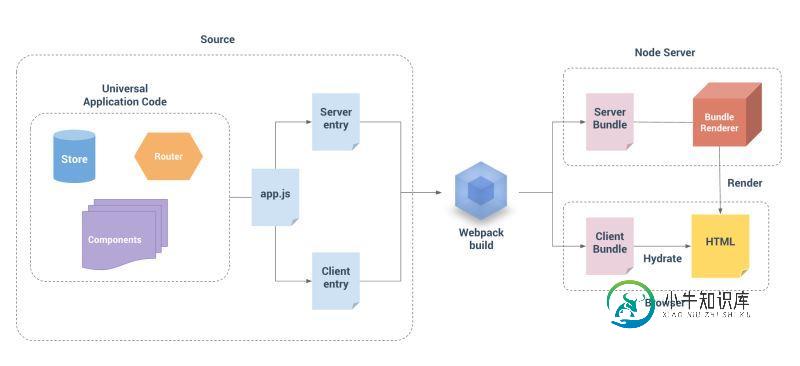Vue.js与 ASP.NET Core 服务端渲染功能整合
http://mgyongyosi.com/2016/Vuejs-server-side-rendering-with-aspnet-core/
原作者:Mihály Gyöngyösi
译者:oopsguy.com
我真的很喜欢在前端使用 Vue.js,Vue 服务端渲染直到第二个版本才被支持。 在本例中,我想展示如何将 Vue.js 服务端渲染功能整合 ASP.NET Core。 我们在服务端使用了 Microsoft.AspNetCore.SpaServices 包,该包提供 ASP.NET Core API,以便于我们可以使用上下文信息调用 Node.js 托管的 JavaScript 代码,并将生成的 HTML 字符串注入渲染页面。
在此示例中,应用程序将展示一个消息列表,服务端只渲染最后两条消息(按日期排序)。可以通过点击“获取消息”按钮从服务端下载剩余的消息。
项目结构如下所示:
. ├── VuejsSSRSample | ├── Properties | ├── References | ├── wwwroot | └── Dependencies ├── Controllers | └── HomeController.cs ├── Models | ├── ClientState.cs | ├── FakeMessageStore.cs | └── Message.cs ├── Views | ├── Home | | └── Index.cshtml | └── _ViewImports.cshtml ├── VueApp | ├── components | | ├── App.vue | | └── Message.vue | ├── vuex | | ├── actions.js | | └── store.js | ├── app.js | ├── client.js | ├── renderOnServer.js | └── server.js ├── .babelrc ├── appsettings.json ├── Dockerfile ├── packages.json ├── Program.cs ├── project.json ├── Startup.cs ├── web.config ├── webpack.client.config.js └── webpack.server.config.js
正如你看到的,Vue 应用位于 VueApp 文件夹下,它有两个组件、一个包含了一个 mutation 和一个 action 的简单 Vuex store 和一些我们接下来要讨论的其他文件:app.js、client.js、 renderOnServer.js、server.js。
实现 Vue.js 服务端渲染

要使用服务端渲染,我们必须从 Vue 应用创建两个不同的 bundle:一个用于服务端(由 Node.js 运行),另一个用于将在浏览器中运行并在客户端上混合应用。
app.js
引导此模块中的 Vue 实例。它由两个 bundle 共同使用。
import Vue from 'vue';
import App from './components/App.vue';
import store from './vuex/store.js';
const app = new Vue({
store,
...App
});
export { app, store };
server.js
此服务端 bundle 的入口点导出一个函数,该函数有一个 context 属性,可用于从渲染调用中推送任何数据。
client.js
客户端 bundle 的入口点,其用一个名为 INITIAL_STATE 的全局 Javascript 对象(该对象将由预渲染模块创建)替换 store 的当前状态,并将应用挂载到指定的元素(.my-app)。
import { app, store } from './app';
store.replaceState(__INITIAL_STATE__);
app.$mount('.my-app');
Webpack 配置
为了创建 bundle,我们必须添加两个 Webpack 配置文件(一个用于服务端,一个用于客户端构建),不要忘了安装 Webpack,如果尚未安装,则:npm install -g webpack。
webpack.server.config.js
const path = require('path');
module.exports = {
target: 'node',
entry: path.join(__dirname, 'VueApp/server.js'),
output: {
libraryTarget: 'commonjs2',
path: path.join(__dirname, 'wwwroot/dist'),
filename: 'bundle.server.js',
},
module: {
loaders: [
{
test: /\.vue$/,
loader: 'vue',
},
{
test: /\.js$/,
loader: 'babel',
include: __dirname,
exclude: /node_modules/
},
{
test: /\.json?$/,
loader: 'json'
}
]
},
};
webpack.client.config.js
const path = require('path');
module.exports = {
entry: path.join(__dirname, 'VueApp/client.js'),
output: {
path: path.join(__dirname, 'wwwroot/dist'),
filename: 'bundle.client.js',
},
module: {
loaders: [
{
test: /\.vue$/,
loader: 'vue',
},
{
test: /\.js$/,
loader: 'babel',
include: __dirname,
exclude: /node_modules/
},
]
},
};
运行 webpack --config webpack.server.config.js, 如果运行成功,则可以在 /wwwroot/dist/bundle.server.js 找到服端 bundle。获取客户端 bundle 请运行 webpack --config webpack.client.config.js,相关输出可以在 /wwwroot/dist/bundle.client.js 中找到。
实现 Bundle Render
该模块将由 ASP.NET Core 执行,其负责:
渲染我们之前创建的服务端 bundle
将 **window.__ INITIAL_STATE__** 设置为从服务端发送的对象
process.env.VUE_ENV = 'server';
const fs = require('fs');
const path = require('path');
const filePath = path.join(__dirname, '../wwwroot/dist/bundle.server.js')
const code = fs.readFileSync(filePath, 'utf8');
const bundleRenderer = require('vue-server-renderer').createBundleRenderer(code)
module.exports = function (params) {
return new Promise(function (resolve, reject) {
bundleRenderer.renderToString(params.data, (err, resultHtml) => { // params.data is the store's initial state. Sent by the asp-prerender-data attribute
if (err) {
reject(err.message);
}
resolve({
html: resultHtml,
globals: {
__INITIAL_STATE__: params.data // window.__INITIAL_STATE__ will be the initial state of the Vuex store
}
});
});
});
};
实现 ASP.NET Core 部分
如之前所述,我们使用了 Microsoft.AspNetCore.SpaServices 包,它提供了一些 TagHelper,可轻松调用 Node.js 托管的 Javascript(在后台,SpaServices 使用 Microsoft.AspNetCore.NodeServices 包来执行 Javascript)。
Views/_ViewImports.cshtml
为了使用 SpaServices 的 TagHelper,我们需要将它们添加到 _ViewImports 中。
@addTagHelper "*, Microsoft.AspNetCore.SpaServices"
Home/Index
public IActionResult Index()
{
var initialMessages = FakeMessageStore.FakeMessages.OrderByDescending(m => m.Date).Take(2);
var initialValues = new ClientState() {
Messages = initialMessages,
LastFetchedMessageDate = initialMessages.Last().Date
};
return View(initialValues);
}
它从 MessageStore(仅用于演示目的的一些静态数据)中获取两条最新的消息(按日期倒序排序),并创建一个 ClientState 对象,该对象将被用作 Vuex store 的初始状态。
Vuex store 默认状态:
const store = new Vuex.Store({
state: { messages: [], lastFetchedMessageDate: -1 },
// ...
});
ClientState 类:
public class ClientState
{
[JsonProperty(PropertyName = "messages")]
public IEnumerable<Message> Messages { get; set; }
[JsonProperty(PropertyName = "lastFetchedMessageDate")]
public DateTime LastFetchedMessageDate { get; set; }
}
Index View
最后,我们有了初始状态(来自服务端)和 Vue 应用,所以只需一个步骤:使用 asp-prerender-module 和 asp-prerender-data TagHelper 在视图中渲染 Vue 应用的初始值。
@model VuejsSSRSample.Models.ClientState <!-- ... --> <body> <div class="my-app" asp-prerender-module="VueApp/renderOnServer" asp-prerender-data="Model"></div> <script src="~/dist/bundle.client.js" asp-append-version="true"></script> </body> <!-- ... -->
asp-prerender-module 属性用于指定要渲染的模块(在我们的例子中为 VueApp/renderOnServer)。我们可以使用 asp-prerender-data 属性指定一个将被序列化并发送到模块的默认函数作为参数的对象。
您可以从以下地址下载原文的示例代码:
http://github.com/mgyongyosi/VuejsSSRSample
总结
以上所述是小编给大家介绍的Vue.js与 ASP.NET Core 服务端渲染功能整合,希望对大家有所帮助,如果大家有任何疑问请给我留言,小编会及时回复大家的。在此也非常感谢大家对小牛知识库网站的支持!
-
注意 本指南需要最低为如下版本的 Vue,以及以下 library 支持: vue & vue-server-renderer 2.3.0+ vue-router 2.5.0+ vue-loader 12.0.0+ & vue-style-loader 3.0.0+ 如果先前已经使用过 Vue 2.2 的服务器端渲染 (SSR),你应该注意到,推荐的代码结构现在略有不同(使用新的 runInNew
-
Vue.js 是构建客户端应用程序的框架。默认情况下,可以在浏览器中输出 Vue 组件,进行生成 DOM 和操作 DOM。然而,也可以将同一个组件渲染为服务器端的 HTML 字符串,将它们直接发送到浏览器,最后将这些静态标记"激活"为客户端上完全可交互的应用程序。
-
问题内容: 我刚刚开始研究ReactJS,发现它为您提供了两种渲染页面的方法:服务器端和客户端。但是,我不知道如何一起使用。是使用两种单独的方法来构建应用程序,还是可以将它们一起使用? 如果可以一起使用,该如何做- 我们是否需要在服务器端和客户端重复相同的元素?或者,我们是否可以仅在服务器上构建应用程序的静态部分,而在客户端构建动态部分,而无需与已经预先渲染的服务器端建立任何连接? 问题答案: 对
-
服务端渲染一个很常见的场景是当用户(或搜索引擎爬虫)第一次请求页面时,用它来做初始渲染。当服务器接收到请求后,它把需要的组件渲染成 HTML 字符串,然后把它返回给客户端(这里统指浏览器)。之后,客户端会接手渲染控制权。 下面我们使用 React 来做示例,对于支持服务端渲染的其它 view 框架,做法也是类似的。 服务端使用 Redux 当在服务器使用 Redux 渲染时,一定要在响应中包含应用
-
准备动作 1、安装nodejs与安装express 安装nodejs教程:http://www.cnblogs.com/pigtail/archive/2013/01/08/2850486.html 安装 express 教程:https://www.wenjiangs.com/doc/f5jxm7ii 2、安装node-jsx(使nodejs支持jsx语法) $ npm install node

